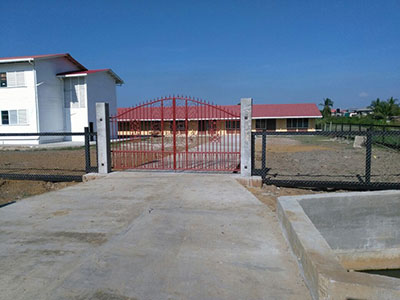IN its continuous efforts to advance disaster preparedness in Guyana, the Civil Defence Commission (CDC) on Friday commissioned the Fort Ordnance Primary School in East Berbice-Corentyne (Region Six) as an emergency shelter, which was done under the “Enhancement of Emergency Shelter Capacity to Mitigate Flood Risk in Ordnance Fortland” project, funded through the Canada-Caribbean Disaster Risk Management Fund.
Deputy Director-General of the CDC, Major Kester Craig who commissioned the centre on behalf of Minister of State with responsibility for Disaster Risk Reduction, Mr. Joseph Harmon, explained that the Fort Ordnance location was selected as a shelter location after the CDC had conducted a hazard and vulnerability assessment in 2015, which showed that the region was highly susceptible to flooding.

“The CDC recognised that there is no designated facility in the region that could effectively serve as an emergency shelter if persons were to be displaced. The norm in Guyana over the years has been to utilise schools for temporary shelter, but the design of most schools does not cater for the basic amenities a shelter requires… The vision of having a designated facility for emergency sheltering was then manifested into the development of a concept,” he said.
The shelter, which serves as the first of its kind in the region and the second country-wide, has the capacity to house approximately 160 persons. The school is now equipped with a concrete bridge to allow the delivery of relief supplies directly to the building, bath facilities, ramps and handrails to improve accessibility for persons living with disabilities, a newly constructed kitchen and feeding area as well as new cooking tools and utensils.
Regional Chairman Mr. David Armagon, explained in addition to the shelter, the region with support from the CDC has a corps of volunteers who have been trained in disaster preparedness and would be immediately activated in the event of a disaster. The chairman also committed to ensuring that the equipment donated would be audited regularly to ensure their safety and longevity
Meanwhile, High Commissioner of Canada to Guyana Ms. Lilian Chatterjee expressed satisfaction with seeing the Guyana-Canada project come to fruition. “I am pleased that Guyana and Canada are able to collaborate once again to increase climate resilience now in Fort Ordnance. This project is a good example of the community coming together with the support of the Canada-Caribbean Disaster Risk Management Funds to strengthen the readiness to respond to natural disasters and climate change,” she said.
In 2012, the Civil Defence Commission opened an emergency centre shelter in Upper Takutu-Upper Essequibo (Region Nine) at the Arapaima Primary School through funding from Caribbean Disaster Emergency Management Agency (CDEMA). Currently, the CDC is in the process of conducting hazard, risk and vulnerability assessments across the country to determine high-risk areas and to identify appropriate buildings that can be transformed into emergency shelters. This activity will be completed within the first quarter of 2018.
(Ministry of the Presidency)



.jpg)








